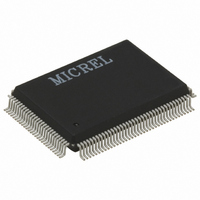KS8997 Micrel Inc, KS8997 Datasheet - Page 16

KS8997
Manufacturer Part Number
KS8997
Description
IC SWITCH 10/100 8PORT 128PQFP
Manufacturer
Micrel Inc
Specifications of KS8997
Applications
*
Mounting Type
Surface Mount
Package / Case
128-MQFP, 128-PQFP
Fiber Support
No
Integrated Led Drivers
Yes
Phy/transceiver Interface
MII
Power Supply Type
Analog/Digital
Package Type
PQFP
Data Rate (typ)
10/100Mbps
Vlan Support
Yes
Operating Temperature (max)
70C
Operating Temperature (min)
0C
Pin Count
128
Mounting
Surface Mount
Jtag Support
No
Operating Temperature Classification
Commercial
Lead Free Status / RoHS Status
Contains lead / RoHS non-compliant
Available stocks
Company
Part Number
Manufacturer
Quantity
Price
Company:
Part Number:
KS8997
Manufacturer:
KENDIN
Quantity:
885
Part Number:
KS8997
Manufacturer:
REALTEK/瑞昱
Quantity:
20 000
Micrel, Inc.
KS8997/KSZ8997
MDI/MDI-X Auto Crossover
The KS8997 supports MDI/MDI-X auto crossover. This facilitates the use of either a straight connection CAT-5 cable
or a crossover CAT-5 cable. The auto-sense function will detect remote transmit and receive pairs, and correctly
assign the transmit and receive pairs from the Micrel device. This can be highly useful when end users are unaware
of cable types and can also save on an additional uplink configuration connection.
The auto MDI/MDI-X is achieved by the Micrel device listening for the far end transmission channel and assigning
transmit/receive pairs accordingly.
Auto-Negotiation
The KS8997 conforms to the auto-negotiation protocol as described by the 802.3 committee. Auto-negotiation allows
UTP (Unshielded Twisted Pair) link partners to select the best common mode of operation. In auto-negotiation the
link partners advertise capabilities across the link to each other. If auto-negotiation is not supported or the link partner
to the KS8997 is forced to bypass auto-negotiation, then the mode is set by observing the signal at the receiver. This
is known as parallel mode because while the transmitter is sending auto-negotiation advertisements, the receiver is
listening for advertisements or a fixed signal protocol.
The flow for the link set up is depicted below. Note that the KS8997 only supports auto-negotiation and not forced
modes.
Figure 4. Auto-Negotiation
16
February 2007
M9999-022807-1.1












